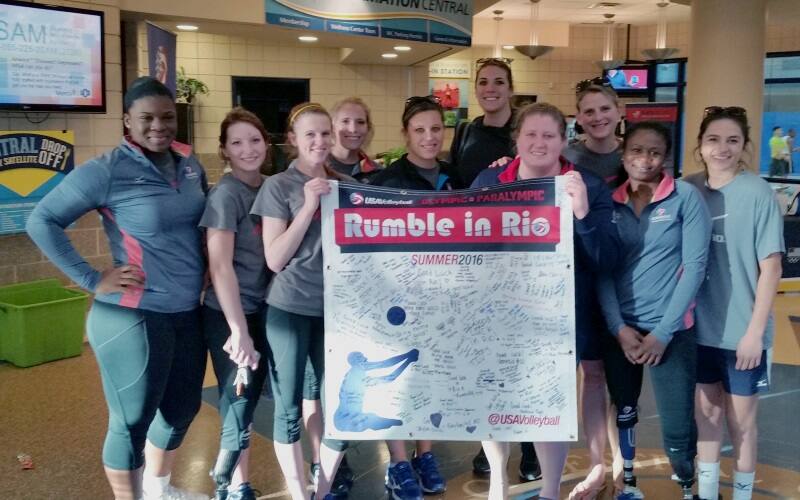
COLORADO SPRINGS, Colo. (March 1, 2016) – When fans and spectators tell Nicky Nieves they didn’t know sitting volleyball existed, the U.S. Women’s Sitting Team athlete jumps at the opportunity to share the sport she loves.
“The most common thing we hear is definitely, ‘I didn’t know this sport existed,’” Nieves said. “I’m very appreciative of that and love to tell people more.”
On Saturday, Nieves and her U.S. Women’s Sitting Volleyball teammates introduced the sport to more than 300 fans during an intrasquad scrimmage at the Tulsa Classic, a junior tournament hosted by Summit Nitro Volleyball, based in Carrollton, Texas.
In addition to the Saturday afternoon scrimmage, the team demonstrated skills, signed autographs and talked to fans about the game.
“It really opens their eyes and shows them a different sport said Heather Erickson of playing in front of youth volleyball players. “They get so excited to see us play, and then you hear them talking about the sport after seeing us play and see them interact with us on social media. It’s really cool.”
The event served as a fundraiser for USA Volleyball’s Sitting Teams program. Sitting Teams Program. Director and Women’s Head Coach Bill Hamiter said about $5,000 has been raised from the junior teams’ tournament entry fees in each of the last three years. The funds help cover basic operating costs and travel-related expenses for the U.S. Men’s and Women’s Sitting Teams.
Similar events also help prepare the Sitting Team for a variety of scenarios outside of their home training gym at the University of Central Oklahoma, Nieves said.
“It’s a different environment to play in and it forces us to overcome things we’re used to,” she explained. “When we got to Tulsa, the gym was darker and the space between (the court and the fans) was wider. I feel like that’s really useful for us because no two matches are going to be the same at big competitions.”
Most importantly, events such as the Tulsa Classic help spread awareness and interest in sitting volleyball.
“The people (who) have never seen sitting volleyball are looking with their mouths dropped open and they’re always amazed,” Hamiter said. “Most people hear (of sitting volleyball) and think, ‘Well, this is some nice little sport for these disabled people,’ and then they see it and go, ‘Holy cow, this is fast and real volleyball.’”
The afternoon in Tulsa provided a break from the gym for the Women’s Sitting Team, who converged on the University of Central Oklahoma from Friday to Sunday for the team’s second training block of 2016. The U.S. Men’s and Women’s Sitting Teams each meet approximately every four weeks at the their headquarters in Edmond, Okla., to train together, perfect new game strategies and work toward their ultimate goal: A Paralympic Games gold in Rio de Janeiro.
The U.S. Men’s Sitting Team most recently trained from Feb. 18-21.
February’s training sessions were the final opportunity for the teams to train before departing for the World ParaVolley Intercontinental Cup in Hangzhou, China, from March 17-23.
Many of the world’s top men’s and women’s sitting teams –including China, ranked No. 1 on the women’s side, and Bosnia Herzegovina, ranked No. 1 on the men’s side – are participating in the tournament, which also serves as a Paralympic qualifier.
Since both the U.S. Men’s and Women’s Sitting Teams already qualified for the Rio games, they will attempt to earn points that affect their seeding at the Paralympic games, Hamiter said.
During their training block, the women focused on perfecting a new offensive strategy Hamiter anticipates the team will debut during the tournament. Some members of the U.S. Men’s National Sitting Team joined in, nurturing a more competitive environment, Erickson said.
“We don’t get to practice a lot with (the men), but it helped playing against them,” Erickson said. “We got to work a lot on the rotation and it helped clear up a lot of stuff for Intercontinental.”
